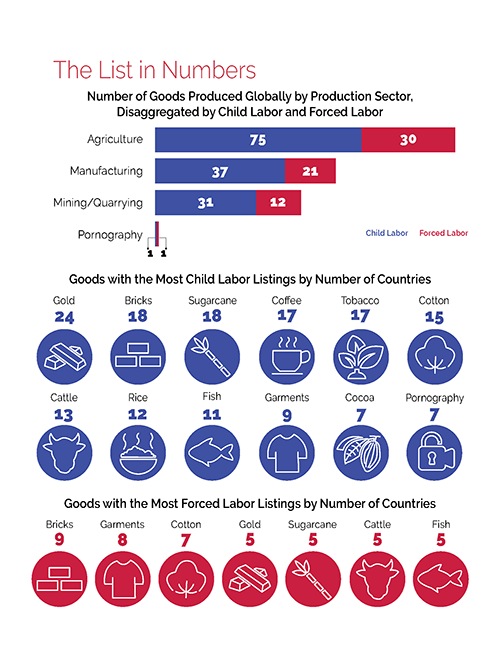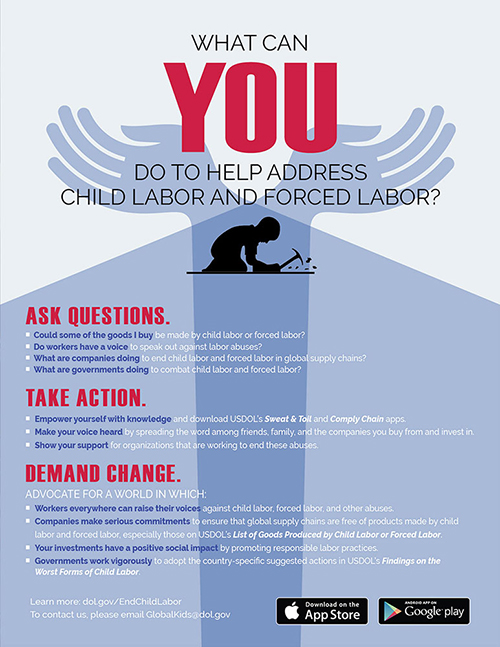List of Goods Produced by Child Labor or Forced Labor
The Bureau of International Labor Affairs (ILAB) maintains a list of goods and their source countries which it has reason to believe are produced by child labor or forced labor in violation of international standards, as required under the Trafficking Victims Protection Reauthorization Act (TVPRA) of 2005 and subsequent reauthorizations. The List of Goods Produced by Child Labor or Forced Labor comprises 159 goods from 78 countries and areas, as of September 28, 2022.
ILAB maintains the List primarily to raise public awareness about forced labor and child labor around the world and to promote efforts to combat them; it is not intended to be punitive, but rather to serve as a catalyst for more strategic and focused coordination and collaboration among those working to address these problems.
Publication of the List has resulted in new opportunities for ILAB to engage with foreign governments to combat forced labor and child labor. It is also a valuable resource for researchers, advocacy organizations and companies wishing to carry out risk assessments and engage in due diligence on labor rights in their supply chains.
The countries on the List span every region of the world. The most common agricultural goods listed are sugarcane, cotton, coffee, tobacco, cattle, rice, and fish. In the manufacturing sector, bricks, garments, textiles, footwear, carpets, and fireworks appear most frequently. In mined or quarried goods, gold, coal and diamonds are most common.
ILAB published the initial TVPRA List in 2009 and updated it annually through 2014, following a set of procedural guidelines that were the product of an intensive public consultation process. ILAB now updates and publishes the List every other year, pursuant to changes in the law.
Procedural Guidelines
On January 25, 2024, ILAB's Office of Child Labor, Forced Labor, and Human Trafficking published Procedural Guidelines for the development and maintenance of the List of Goods from countries produced by child labor or forced labor in violation of international standards.
| Country/Area Sort descending | Good | Exploitation Type |
|---|---|---|
| Côte d'Ivoire | There are reports that children ages 14-17 and younger in Côte d'Ivoire are forced to work on coffee plantations. Based on a research study, thousands of children are involved in this type of labor. Some children are forcibly recruited, or recruited through deceptive means, and transported to coffee plantations in Côte d'Ivoire from nearby countries including Benin, Mali, Togo, and Burkina Faso. These children are sold to traffickers. Other children leave their home countries or communities voluntarily, but end up in situations where they are not paid and have no means to return home. Some children are forced to work for three or four years before receiving payment or returning home. Others are forced to work, even if sick, and prevented from leaving the plantations through threat of physical violence, withheld payments, or denial of food. |
Child Labor, Forced Labor |
| Dominican Republic | Child Labor | |
| Dominican Republic | Child Labor | |
| Dominican Republic | Child Labor | |
| Dominican Republic | There are reports that adults are forced to work in the harvesting and production of sugarcane in the Dominican Republic. These adults, the majority of whom are undocumented or stateless, are predominantly of Haitian origin or descent. Reports from civil society organizations, news media, worker interviews, field research, and other sources indicate the existence of the following forced labor indicators in the sugarcane sector: withholding of wages, abusive working and living conditions, excessive overtime, isolation and restriction of movement, and deceptive recruitment practices. For some workers, a precarious legal status and lack of identity documents limit their movement and have led to isolation and fears of reprisal, denouncement to authorities, loss of company-provided housing and deportation for complaining about unlawful labor conditions. In addition, illiteracy, low levels of education, and language barriers can impede their understanding and exercising of labor rights, thus increasing their vulnerability to labor exploitation. |
Child Labor, Forced Labor |
| Dominican Republic | Child Labor | |
| Ecuador | Child Labor | |
| Ecuador | There are reports that children ages 5 to 17 work in the production of rice in Ecuador. Based on the analysis of Ecuador’s 2019 National Survey of Employment, Unemployment, and Underemployment, an estimated 5,896 children under the minimum age for work are involved in child labor in rice production. The ILO has found that generally, children who work in agriculture may be at risk of exposure to hazards including working long hours, carrying heavy loads, using dangerous tools, exposure to the elements, physical injuries, and chemicals, such as pesticides. The release of this survey demonstrates the Government of Ecuador’s commitment to addressing child labor and its acknowledgement that data collection is vital to the design and implementation of sound policies and programs. |
Child Labor |
| Ecuador | Child Labor | |
| Ecuador | There are reports that children ages 5 to 17 work in bovine raising in Ecuador. Based on the analysis of Ecuador’s 2019 National Survey of Employment, Unemployment, and Underemployment, an estimated 10,564 children under the minimum age for work are involved in child labor in bovine raising. The ILO has found that generally, children who care for farm animals may be at risk of exposure to potential health consequences, including injuries from kicks and infections from animal bites and exposure to harmful bacteria. The release of this survey demonstrates the Government of Ecuador’s commitment to addressing child labor and its acknowledgement that data collection is vital to the design and implementation of sound policies and programs. |
Child Labor |
your hand? Download ILAB's Sweat & Toil App today!
Are you a company looking to fight child labor and forced labor in supply
chains?





